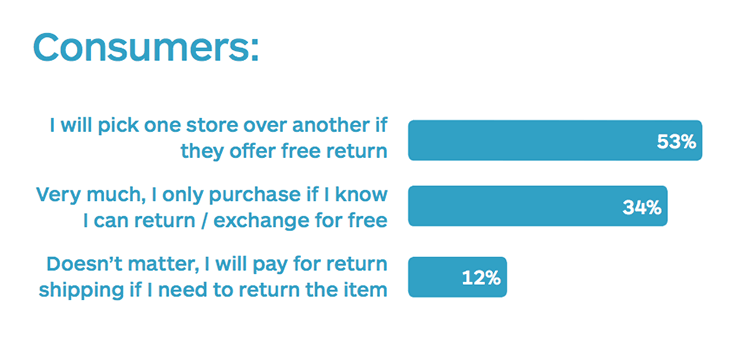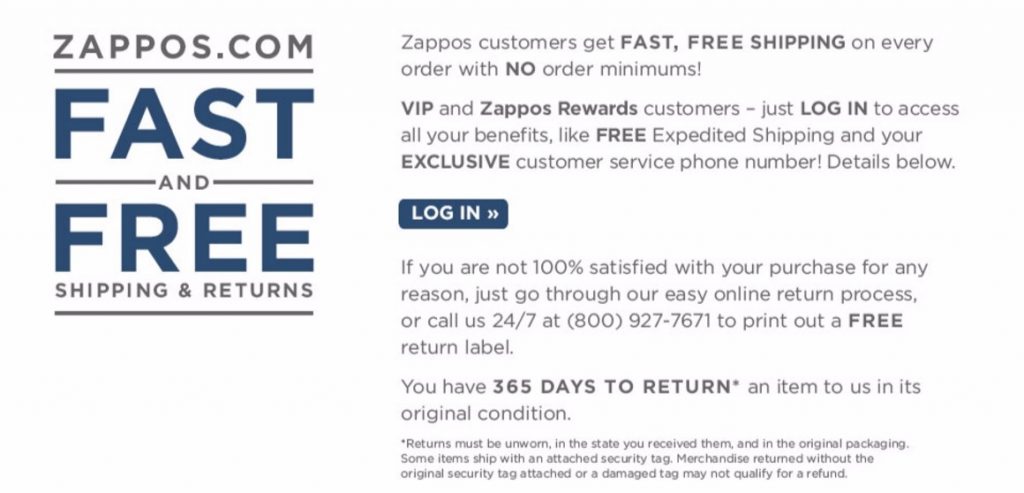Free Shipping, Free Returns: How to Manage Customer Expectations Without Sinking


Online returns: Every retailer’s favorite part of January, right?
With the influx in returns that are sure to happen all month long, online merchants should be prepared to make good on their preexisting return policy, potentially pay for return shipping, issue refunds, and deal with unwanted goods.
This is especially true for apparel retailers, who started off 2016 with a 30% return rate, according to Fashion Metric.
Your return policy can either protect and sustain or irreparably harm your business. Today, we’re going to cover what you can expect once the holidays are over, and how to survive when the returns come in. And if your current policy is lacking, here’s how to prep for next year.
According to IHL research, retailers lose about $642.6 billion every year from preventable returns.
 “Take great pictures of your products and make sure your descriptions are accurate and up-to-date,” says Joey Blanco, Content Manager at Shipstation.
“Take great pictures of your products and make sure your descriptions are accurate and up-to-date,” says Joey Blanco, Content Manager at Shipstation.
“Investing in a DSLR camera can help make sure your products stand out on your site and provide your customers with a look at all angles. Digging deeper, make sure you’re sending the right product.”

“Pick lists and packing slips and an easily organized warehouse, garage, and/or shelving can cut down on the wrong product finding its way into a box. Having a second set of eyes confirming that what’s in the box is what was ordered helps, too,” Blanco adds.
It could also be a great way to cut back on credit card chargebacks.
 Jeremy Bodenhamer, Co-Founder and CEO of Shiphawk, agrees.
Jeremy Bodenhamer, Co-Founder and CEO of Shiphawk, agrees.
“Provide clear details in advance, pictures, descriptions and anything else the customer needs to make a good buying decision. It’s better to make wise decisions about operations than wish [returns] would go away.”
What about drop shipping? Is it ever a good idea to relinquish shipping control on your products?
There are pros and cons.
“Dropshipping, especially around the holiday season, can allow you to focus on selling, promoting, and marketing your business,” says Blanco. “But dropshipping—and delegating in general—is dependent on your specific situation.”
As a general rule of thumb, handcrafted made-to-order products are best shipped under your watchful eyes, and not with a drop shipper–even if that means adding temporary hires to deal with additional shipping and returns.
The key, according to Blanco, is to test your drop shipper during a low season.
“A little experimenting before implementation can be the difference between a quality shipping experience and disaster,” says Blanco.
According to a 2016 survey from Shippo, most customers factor in your return policy before they make a purchase:

Unfortunately, while heavyweights like Zappos have set the gold standard for ecommerce returns, many stores can’t offer the same type of policy without sinking.
Zappos customers have an entire year to return an item, as long as it’s in the original condition. For free. The price is especially key–customers no longer expect to have to pay for a return, and that’s reinforced by Amazon Prime standards.
“The Zappos model is the one to beat right now,” says Blanco.
“Online shoppers will abandon their cart if they see that they’ll need to cover any part of the returns process. If customers make a purchase and have to pay to return an item—whether shipping, restocking, or any other fee—they won’t come back.”
However, is it possible for every online retailer to do what Zappos does?
“I don’t think emulating is the right move for any business,” says Bodenhamer. “I think it is important to recognize the reasons that companies like Amazon and Zappos have had such success. They did so by understanding customer expectations, figuring out how to meet them and then using that scale to reset those expectations in the larger market.
 Amazon knew customers wanted free shipping. Zappos knew they wanted free returns.
Amazon knew customers wanted free shipping. Zappos knew they wanted free returns.
Both companies figure out ways to offer these and make the programs unique to their businesses.
Amazon’s shipping isn’t even free, it is just marketed that way, and the Prime business model feels free because members are paying their membership fee in advance.”
That seems to be the key to Amazon’s ability to offer free shipping. Prime customers may not know it, but they’re paying every month for the privilege of free shipping and returns.
The most important thing for merchants to do is to make sure they’re balancing the cost of returns with price and overhead, which is easier said than done.

“Returns are inevitable, no matter how great your product descriptions or photos,” says Blanco.
“If you go into selling expecting X% of items to be returned, you can add that expense into the product pricing or shipping costs so when the return comes around, your bottom line doesn’t take a hit.”
Beyond making returns “free,” you should also make returns as easy as possible. One of the biggest mistakes online merchants make is not making returns easy.
“Include a prepaid return label in the box,” says Bodenhamer. “If you make it easy for customers to do business with you, they will come back. Don’t make your customers work to do business with you, regardless of whether it is a purchase or a return.”
So you’ve made returns free and easy for your customers–but what about your bandwidth?
This is where shipping software and automation come in handy.
“So much time is lost manually selecting shipping services, applying weights, and printing labels one-by-one,” says Blanco. “If you’re not using a shipping software, find one. If you already have one, start automating processes.
If carrier services and weights can be applied at import, all you need to do is batch print orders all at once and pack the orders.
If your warehouse has a barcode scanner, you can even use barcodes to perform actions like print a label, apply a service. Whatever you can do to automate repetitive tasks, do it!”
Bodenhamer agrees that automation is the way to go. And the bonus is when you do automate tasks, you reduce the risk of errors:
“Remove as many of the manual customer service components as possible.
Use automation to keep customers up-to-date on their orders from the moment they make a purchase, and make sure all the tools they need to process returns or get answers to questions are pre-emptive or only a click away. And once again, include a return label in the original box.”
At the end of the day, the most important thing is to make returns free and easy for customers and automated for you.
That will save you a lot of the manpower and time that you probably expended during the holidays. If it’s too late to adjust your strategy, 2017 is a perfect time to reassess the way you fulfill orders and deal with returns.
What are you expecting to deal after the holidays? How do you make shipping and returns easier? Share in the comments below.
